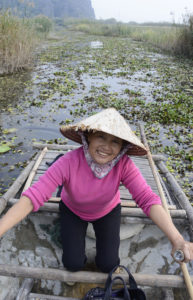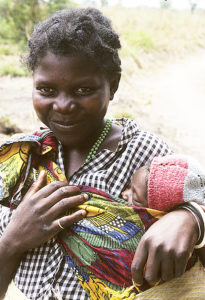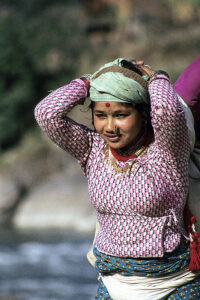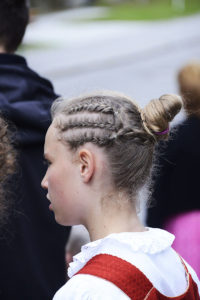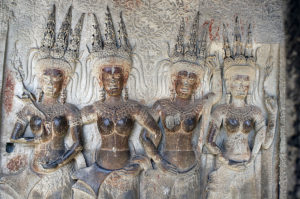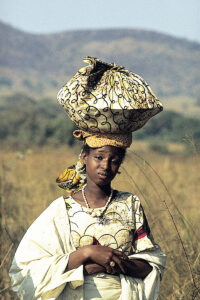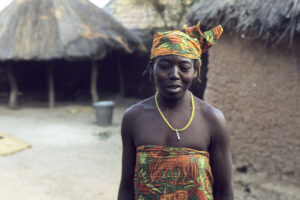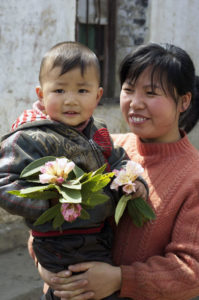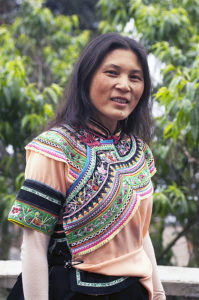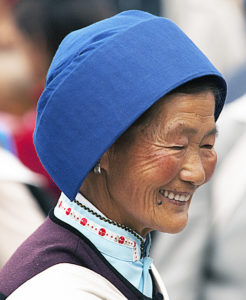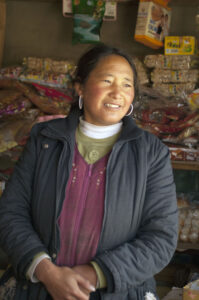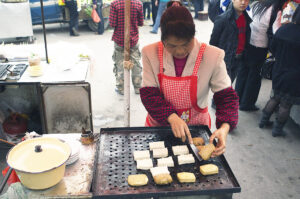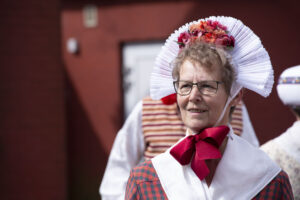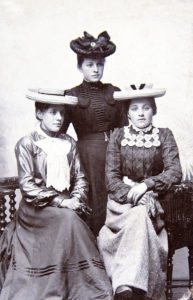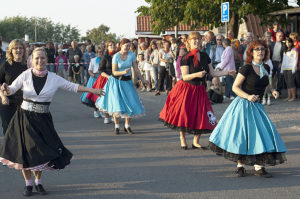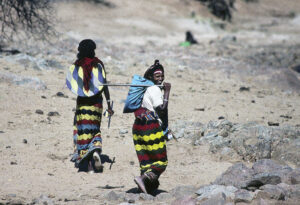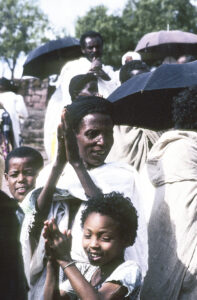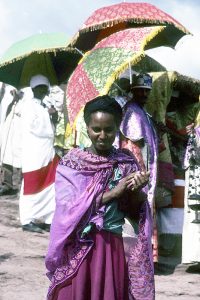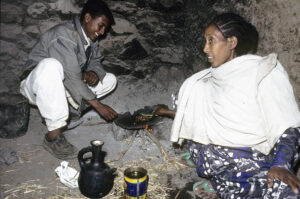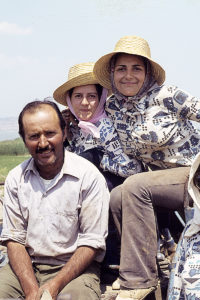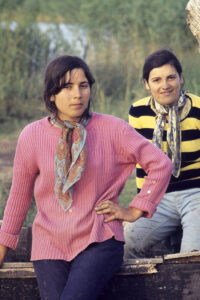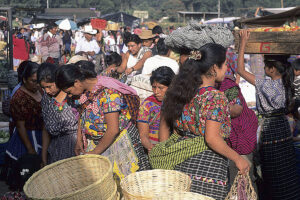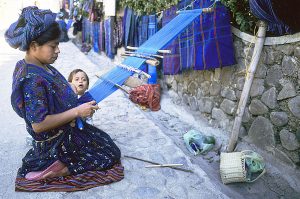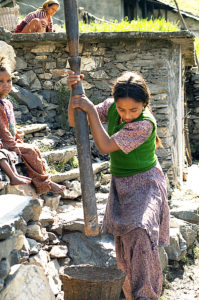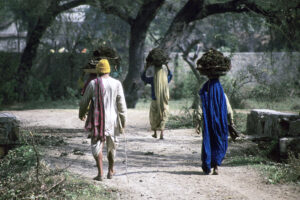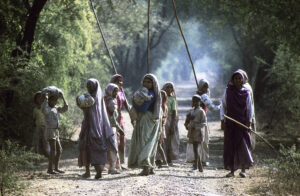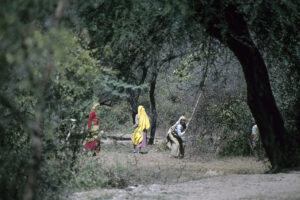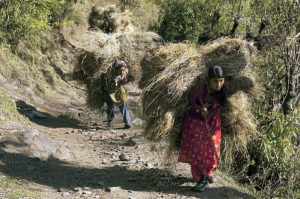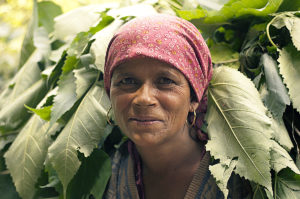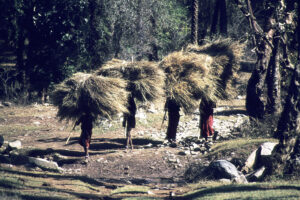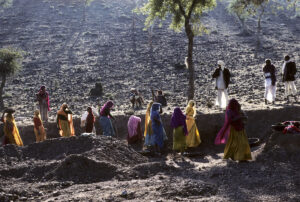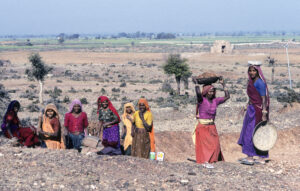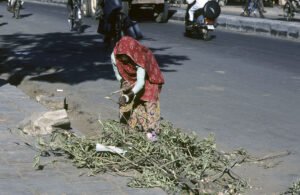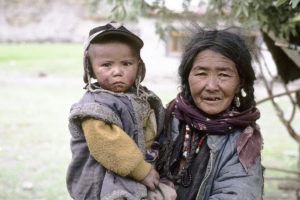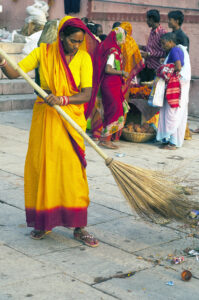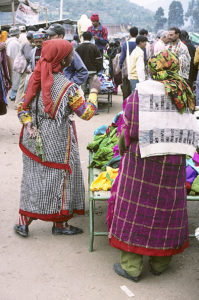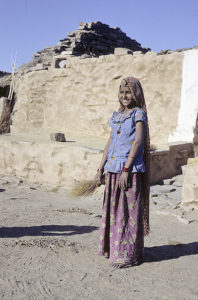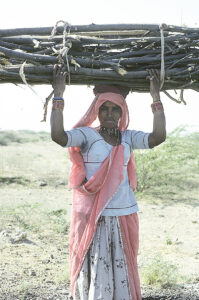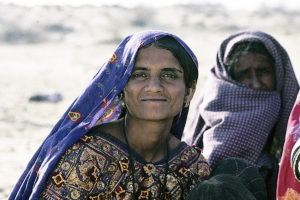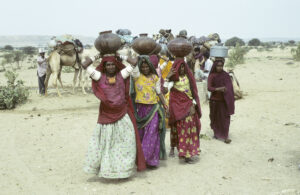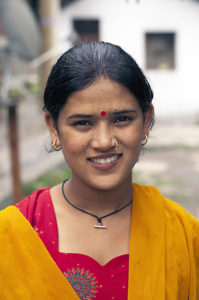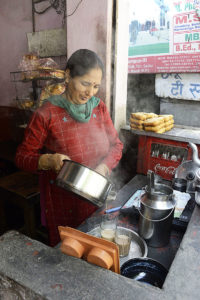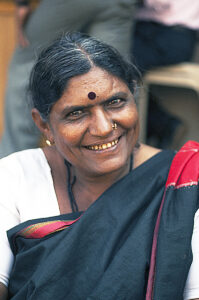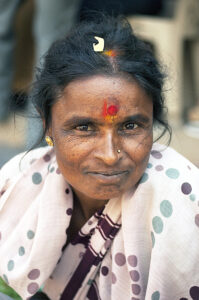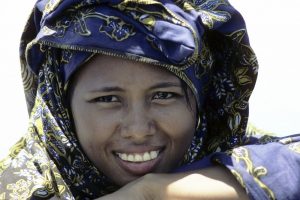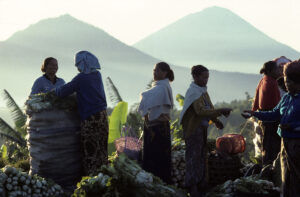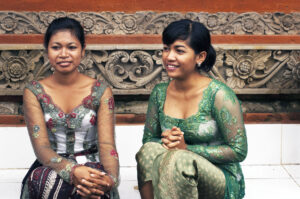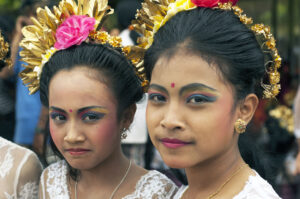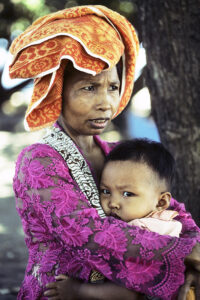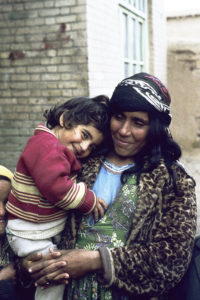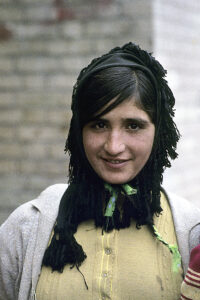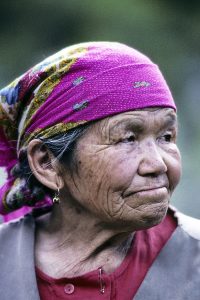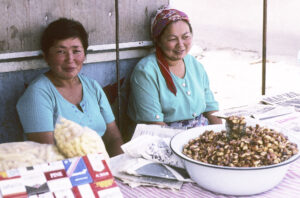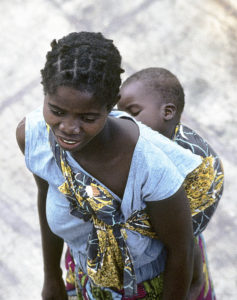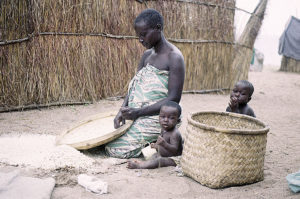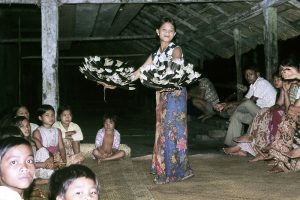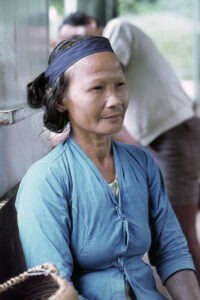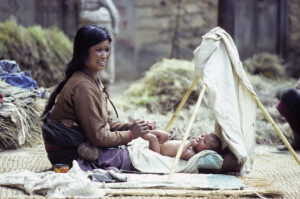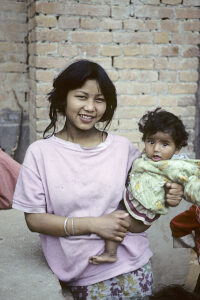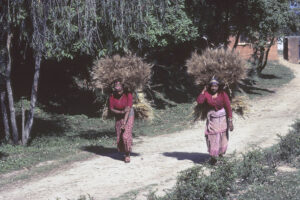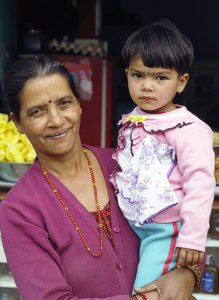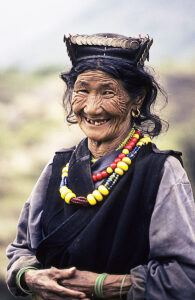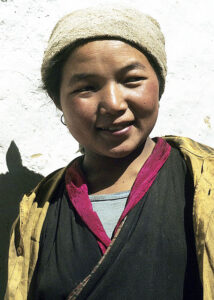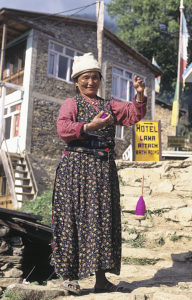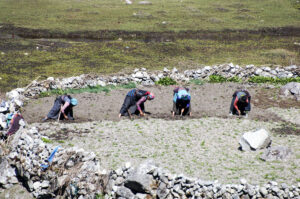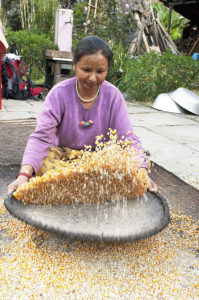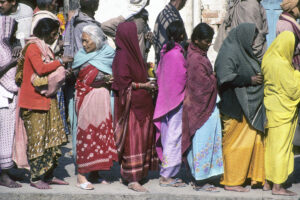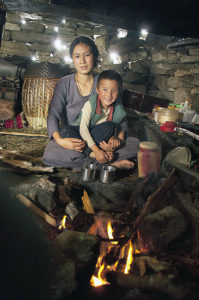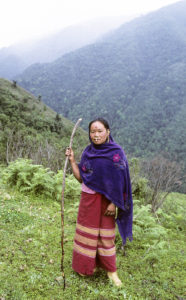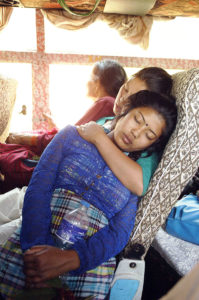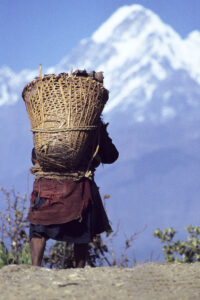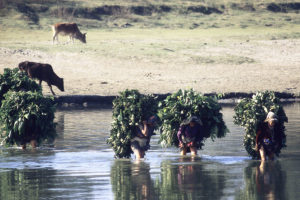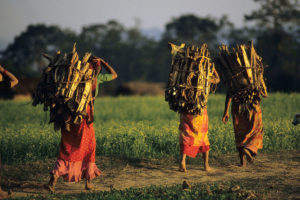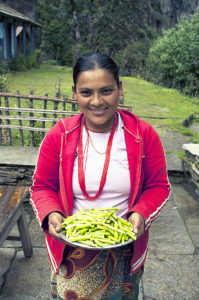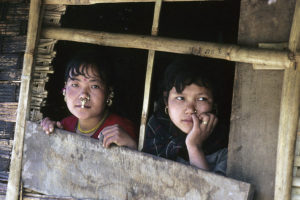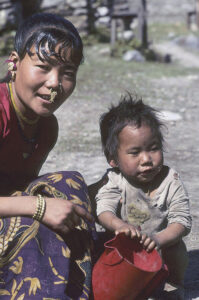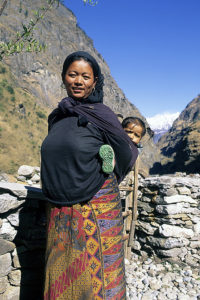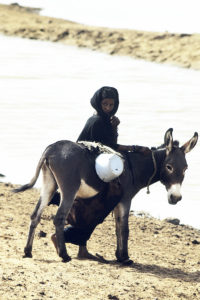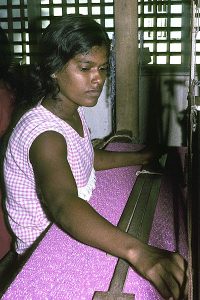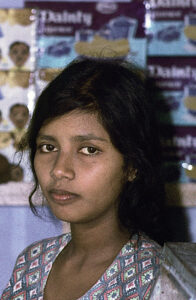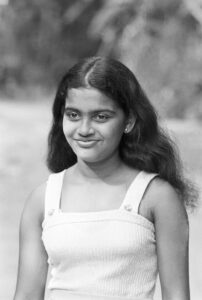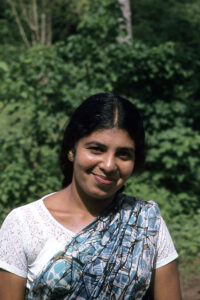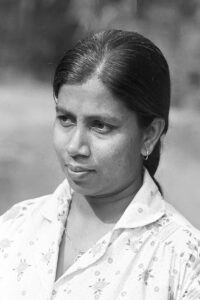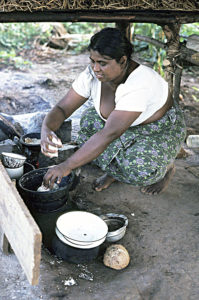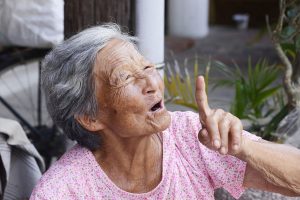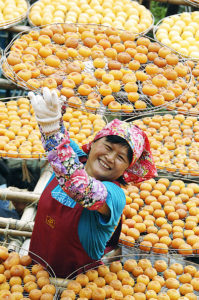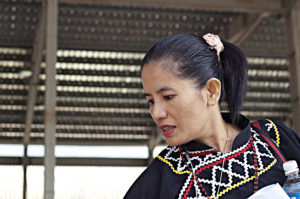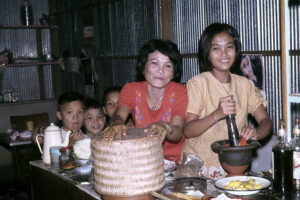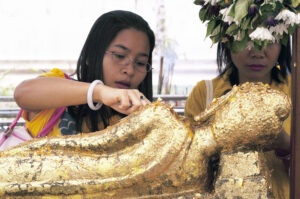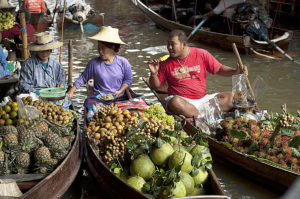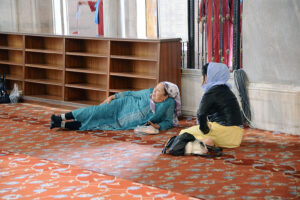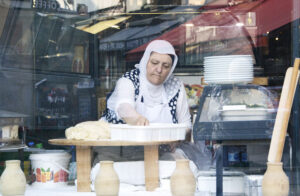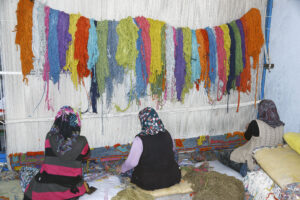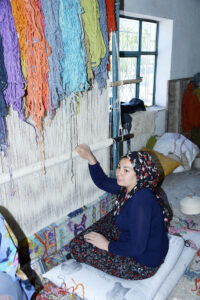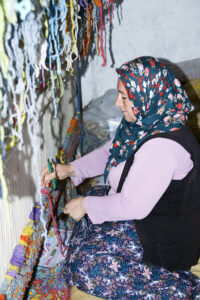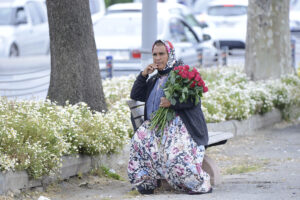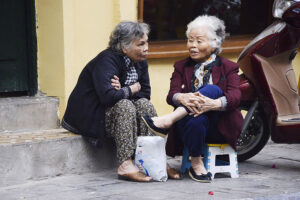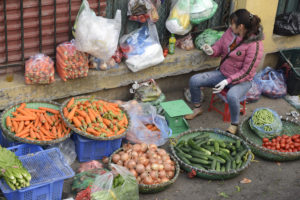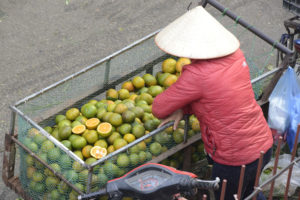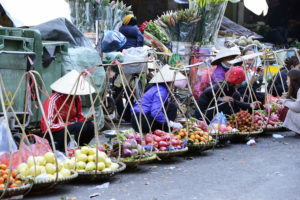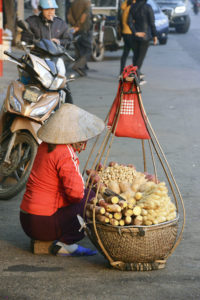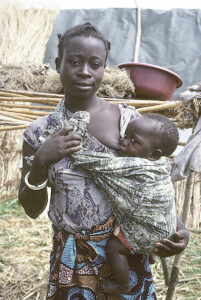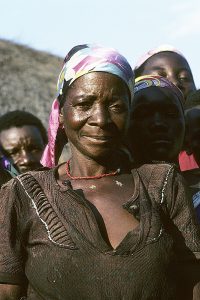Women are more than half of the world
Slender girl, clad in a red sari, Rajasthan, India. (Photo copyright © by Kaj Halberg)
This woman gets an income from rowing tourists around in the Van Long Nature Reserve, Vietnam. (Photo copyright © by Kaj Halberg)
Young Bena Kabende mother, Manokola, northern Zambia. (Photo copyright © by Kaj Halberg)
This healthy, strong girl in the Trisuli Valley, Nepal, is carrying a heavy sack of millet. (Photo copyright © by Kaj Halberg)
The vast majority of women are exceedingly hard-working, occupied with various tasks, including cooking, cleaning, childcare, and field work. Generally, men are working much less, often sitting in groups all day long, drinking alcohol and commenting on the world around them. Today, when many women have jobs on par with men, their husbands often expect them also to cook and take care of the children.
Yes, women are indeed more than half of the world.
Like most men, I have an eye for beauty and grace in females of all age groups. This page shows a collection of pictures of women, old and young, whom I found attractive in one way or another, sometimes just by the dignified way they were carrying themselves, sometimes through the way they were working.
But first two poems and an extract from a book.
Drink to me only with thine eyes,
And I will pledge with mine;
Or leave a kiss within the cup,
And I’ll not ask for wine.
The thirst that from the soul doth rise
Doth ask a drink divine;
But might I of Jove’s nectar sup,
I would not change for thine.
I sent thee late a rosy wreath,
Not so much honoring thee
As giving it a hope, that there
It could not withered be.
But thou thereon didst only breathe,
And sent’st it back to me;
Since when it grows, and smells, I swear,
Not of itself, but thee.
From the poem To Celia, by English playwright and poet Benjamin Jonson (1572-1637).
The kitchen has been cleaned, everything is stowed away,
The tap is dripping in the sink.
The sun is glinting in cups, plates and glasses,
Glowing in the cherry wine bottle.
A rag is hanging over the faucet.
A fly is buzzing in the window, trying to get out,
Otherwise everything is very quiet.
The living room is quiet, the air is stale,
The clock is killing time.
In here, time is neither short nor long,
But the quietness is threatening and repressing.
Against the wall, in a chair at the table,
Sits Marie, sleeping in the sun.
In here, life is walking on clutches.
Marie is old, and now she is tired,
Her hands cannot do anything anymore.
She lived her life, she has laughed and wept,
And now she is tired of days.
Her husband was a first mate,
Who passed away one stormy night
On one of the seven seas.
Now she is sitting here, like a dark silhouette,
The Bible in front of her on the table,
It is just like her, dark-clad and worn,
Marie lives according to the Gospels.
The light is shining around her, so light and so fine,
Tenderly broken by the lace curtain,
Landing like snow flakes in her hair.
She is like a beautiful melody in minor,
A flower bitten by frost.
A life that has ended, a glow that has become cold,
A vessel approaching the coast.
When she was young she was lovely, but now she is beautiful,
Now, when the coil is nearing its end,
Like corn when ready to harvest.
Translation of the poem Maries efterår (‘Marie’s autumn’), from the LP Til Ane (1975), written in a local Danish dialect by Niels Hausgaard (born 1944), composer, musician, author, entertainer, and much more. In my opinion one of the most beautiful poems written about women.
“(The car) stopped just before us, with a rock and another cloud of dust, and a youthful female head popped out the passenger side window.
“You boys wunna rod?” she called.
“Yes, ma’am, we sure do,” we said, putting on our best behavior.
(…)
Her name was Donna, and they were on their way to some desperate-sounding community – Turkey Balls Falls or Coon Slick or someplace – another fifty miles up the road, but they were pleased to drop us in Hiawassee, if they didn’t kill us all first. Darren drove at 127 miles an hour with one finger on the wheel, his head bouncing to the rhythm of some internal song, while Donna twirled in her seat to talk to us. She was stunningly pretty, entrancingly pretty.
“Y’all have to excuse us. We’re celebrating.” She held up her plastic cup as if in toast.
“What’re you celebrating?” asked Katz.
“We’re gittin married tomorrah,” she announced proudly.
“No kidding,” said Katz. “Congratulations.”
“Yup. Darren yere’s gonna make a honest woman outta me.”
From the book A Walk in the Woods (1998), by American author William Bryson (born 1951).
Austria
These young women are working as bar maids in a hotel in the town of Annaberg im Lammertal, Salzburg. (Photo copyright © by Kaj Halberg)
Young girl with an interesting hairstyle, Tirol. (Photo copyright © by Kaj Halberg)
Cambodia
The Khmer Empire (802-1431 A.D.) was a Southeast Asian Hindu kingdom, which left a superb legacy in the form of the Angkor Wat ruins, in present-day Cambodia.
In Hinduism, apsaras are supernatural female beings, superb in the art of dancing. They are often depicted, dancing to music, delivered by gandharvas, court musicians of the rain god Indra. Apsaras entertain and sometimes seduce gods and men.
This Khmer relief at Angkor Wat may depict apsaras. The dark smudges on their breasts are caused by numerous visitors, who seem to get some pleasure out of touching them! (Photo copyright © by Kaj Halberg)
Cameroun
This woman is walking along a road near Ngaunderé, balancing a dish on her head. (Photo copyright © by Kaj Halberg)
Village woman, near Garoua. (Photo copyright © by Kaj Halberg)
China
Mother and son with rhododendron flowers, Wumeng Shan Mountains, Guizhou Province. Numerous species of rhododendron are presented on the page Plants: Rhododendrons. (Photo copyright © by Kaj Halberg)
The Yunnan Province of south-western China is home to at least 25 tribal peoples, who often wear very colourful traditional dresses. A large number of pictures, depicting these and other Chinese tribal peoples, may be studied on the page People: Chinese minorities.
This young woman of the Yi minority is clad in traditional dress, Yuanyang. (Photo copyright © by Kaj Halberg)
This elderly woman of the Nakhi (Naxi) people, clad in traditional dress, performs a dance in the town of Lijiang. (Photo copyright © by Kaj Halberg)
Tibetan women, east of Zhongdian. (Photos copyright © by Kaj Halberg)
Woman, frying tofu at her food stall, Guiyang, Guizhou Province. (Photo copyright © by Kaj Halberg)
Denmark
Folk dancer, wearing local traditional dress, Bornholm. (Photo copyright © by Kaj Halberg)
Three Danish graces in their best finery, c. 1920. (Photo: Public domain)
Open-air line dance performance, Bornholm. (Photo copyright © by Kaj Halberg)
Egypt
This woman is balancing a bag and a cardboard box on her head, Aswan. (Photo copyright © by Kaj Halberg)
Ethiopia
Oromo women, on their way to dig for gold in the Dawa River, southern Ethiopia. (Photo copyright © by Kaj Halberg)
These women are clapping during celebration of the Christian festival Timkat, the Ethiopian Tewahedo Church Epiphany, in Lalibela. This festival is best known for its ritual re-enactment of baptism, celebrating the baptism of Jesus Christ in the Jordan River. (Photos copyright © by Kaj Halberg)
In Lalibela, we hired this young man as a guide. Here, he and his mother are roasting coffee beans, after which we were served delicious, strong coffee. (Photo copyright © by Kaj Halberg)
Greece
These people enjoy a break during their work, planting tobacco, near Koroneia, northern Greece. (Photo copyright © by Kaj Halberg)
Elderly women chatting during a shopping trip, Chania, Crete. (Photo copyright © by Kaj Halberg)
Girls, near Koroneia, northern Greece. (Photo copyright © by Kaj Halberg)
Guatemala
Markets in Guatemala are a blaze of colours, the women wearing a blouse, called huipil, consisting of several layers of cloth, sown together into intricate patterns. Every village in Guatemala has its own distinct huipil colours and patterns, and almost every woman weaves the cloth for her huipil herself. These gorgeous blouses constitute a part of the daily dress – not only worn at religious festivals or other important events, as one might judge from the beauty of them.
Guatemala is described in depth on the page Travel episodes – Guatemala 1998: Country of the Mayans.
Women at a market in Antigua, wearing colourful huipils. (Photos copyright © by Kaj Halberg)
This woman in the village of Santa Catarina Palomo, on the shore of Lago Atitlán, is busy weaving a blue huipil, blue being a typical colour of this village. (Photo copyright © by Kaj Halberg)
India
With a long wooden pestle, this young woman in the village of Agora, Asi Ganga Valley, Uttarakhand, is pounding her crop of wheat in a basket, hereby removing the husks. A hike up this valley is described on the page Travel episodes – India 2008: Mountain goats and frozen flowers. (Photo copyright © by Kaj Halberg)
These village women have been collecting dung from buffaloes, which graze in Keoladeo National Park, Rajasthan. The dung is dried and stored, to be used later as fuel. (Photo copyright © by Kaj Halberg)
Indian village women often collect fodder for their cattle in the forest or on grass-clad slopes.
Village women on their way into Keoladeo National Park, Rajasthan, to collect fodder. They use the bamboo poles, which has a hook attached at the top, to break off branches from the trees. This action is encouraged by the park staff, as most of the tree species in the park are invasive plants, which were originally planted in the area. (Photos copyright © by Kaj Halberg)
This woman is carrying a huge bundle of cut grass, Charbhuja, Rajasthan. (Photo copyright © by Kaj Halberg)
Staggering under their huge loads, these women from the village of Agora, Asi Ganga Valley, Uttarakhand, carry home bundles of hay. (Photo copyright © by Kaj Halberg)
This woman from the Tirthan Valley, Himachal Pradesh, has been collecting a huge bundle of foliage. (Photo copyright © by Kaj Halberg)
These women have collected huge bundles of grass in Sariska National Park, Rajasthan. (Photo copyright © by Kaj Halberg)
Female road workers, Sawai Madhopur, Rajasthan. The women work, while the men talk or rest in the shade. (Photos copyright © by Kaj Halberg)
This woman is breaking branches, presumably to be used as fodder, Jaipur, Rajasthan. (Photo copyright © by Kaj Halberg)
In the Himalaya, grandparents are highly respected, often participating in the upbringing of their grandchildren. I met this elderly woman with her grandson near the village of Umlung, Ladakh. (Photo copyright © by Kaj Halberg)
Woman, sweeping the stairs leading down to the Ganga River (Ganges), Varanasi. (Photo copyright © by Kaj Halberg)
Clad in beautiful local dresses, these Muslim women are shopping at a market in Kullu, Himachal Pradesh. (Photo copyright © by Kaj Halberg)
The vast Thar Desert stretches across the state of Rajasthan, north-western India, and further west into Pakistan. The main part of this desert is level sand or gravel plains with scattered bushes and trees.
This desert is surprisingly densely populated, inhabited by a number of peoples, who belong to various religions, such as Jains, Bishnoi, Muslims, and Hindu Rajputs. Scattered across the bleak landscape lie numerous towns and villages. One such town is Jaisalmer, close to the Pakistani border, which was founded in 1156 by a Rajput prince, Roa Rawal Jaisal.
This fascinating desert is described in depth on the page Travel episodes – India 2003: Camel safari in the Thar Desert, whereas the Bishnoi people are dealt with on the page Travel episodes – India 1991: Bishnoi people live in harmony with nature.
Woman, sweeping her courtyard in a village in the Thar Desert. (Photo copyright © by Kaj Halberg)
Young Bishnoi woman, carrying water to her home from the village well, near Jodhpur. (Photo copyright © by Kaj Halberg)
This woman has been collecting firewood in the Thar Desert near Jodhpur. (Photo copyright © by Kaj Halberg)
Muslim women from the village of Bambara in the heart of the Thar Desert, near the Pakistani border. Note the huge adornment in the nostril of one of the women. (Photos copyright © by Kaj Halberg)
Women with water jars at a well near the village of Bhopa, Thar Desert. (Photo copyright © by Kaj Halberg)
Young woman from the town of Gushaini, Tirthan Valley, Himachal Pradesh. The red mark between her eyebrows, called a tika, indicates her status as a married woman. People in this area are Hindus of Caucasian origin, who migrated here from Rajasthan hundreds of years ago. (Photo copyright © by Kaj Halberg)
This woman, who owns a tiny restaurant in the town of Pandoh, Himachal Pradesh, is making tea, adding liberal amounts of milk and cardamom seeds. (Photo copyright © by Kaj Halberg)
Hindu women in the town of Karwar, Karnataka, South India. The tika mark on their forehead indicate their status as married women. Multi-coloured marks, as the one on the forehead of the woman in the lower picture, are usually applied only during Hindu festivals. (Photos copyright © by Kaj Halberg)
Indonesia
Young Muslim woman in the town of Sapé, Sumbawa. Note that her front teeth have been filed down, probably an ideal of beauty on this island. (Photo copyright © by Kaj Halberg)
Women at dawn, waiting to sell their vegetables, Kintamani, Bali, Indonesia. The volcanoes in the background are Gunung Abang (2155 m, left) and Gunung Agung (3031 m). The latter is the highest mountain in Bali. (Photo copyright © by Kaj Halberg)
Women and girls, dressed in their finery for a dancing performance during a Hindu temple festival, Ubud, Bali. (Photos copyright © by Kaj Halberg)
The headdress of this Muslim woman on the island of Lombok is a beautifully folded towel. (Photo copyright © by Kaj Halberg)
Iran
The Lur are a people who live in the Zagros Mountains in south-western Iran. In 1973, I spent about six weeks in this area. My at times rather bizarre adventures in this area are related on the page Travel episodes – Iran 1973: In the mountains of Luristan.
Lur mother and daughter. (Photo copyright © by Kaj Halberg)
Young woman of the Lur tribe. (Photo copyright © by Kaj Halberg)
Kyrgyzstan
In the summertime, a small number of Kyrgyz still live a semi-nomadic life. This picture shows an elderly woman, photographed in the Karakol Valley, Tien Shan Mountains. (Photo copyright © by Kaj Halberg)
Kyrgyz saleswomen at a market, Karakol. (Photo copyright © by Kaj Halberg)
Malawi
The Achewa are a Bantu tribe, living around the southern part of Lake Malawi.
Young Achewa woman, carrying her child on her back, Monkey Bay. (Photo copyright © by Kaj Halberg)
Achewa woman in the village of Chembe, cleaning maize. (Photo copyright © by Kaj Halberg)
Malaysia
The indigenous population of Borneo is a multitude of Malayan tribes, known by the common name Dayaks. One of these peoples are the Punan, who live along the Rajang River, Sarawak. My visit to a Punan village is related on the page Travel episodes – Borneo 1975: Canoe trip with Punan tribals.
This young Punan girl performs a dance, with fans of hornbill feathers attached to her wrists, which are moved gracefully in time with the music. (Photo copyright © by Kaj Halberg)
Dayak woman, Belaga, Sarawak. (Photo copyright © by Kaj Halberg)
Nepal
The majority of the inhabitants in Kathmandu Valley are Newars, a people of mixed Caucasian and Mongoloid origin.
Newar woman, applying oil to her baby’s skin. (Photo copyright © by Kaj Halberg)
This Newar woman is cleaning dishes by scrubbing them with ashes. (Photo copyright © by Kaj Halberg)
Young Newar woman with her child. (Photo copyright © by Kaj Halberg)
These Newar women from Bhaktapur, clad in bright red blouses typical of this city, bring home wheat harvest. (Photo copyright © by Kaj Halberg)
Newar woman with her granddaughter. (Photo copyright © by Kaj Halberg)
About 500 years ago, the Sherpa, a Tibetan tribe of pastoral nomads, migrated south and settled in several separate areas: Langtang, Helambu, Solu-Khumbu, and Arun Valley in Nepal, and Darjiling in India. In Tibetan, sherpa means ‘a person from the East’, relating to the fact that the Sherpa originated in eastern Tibet. Today, they number about 150,000, and they still speak a Tibetan dialect.
The Sherpa are Lama Buddhists, mainly of the Nyingma-pa School (also called ‘red-hats’, because the high lamas of this sect wear red hoods). Women have a very high status among the Sherpa, and usually weddings are not arranged by the parents. Sherpas love to eat meat, but their Buddhist religion condemns killing of any creature, so the slaughtering is done by non-Buddhist Tibetans. Only domestic animals are eaten, and wildlife in Sherpa areas is generally left in peace.
Among Westerners, the Sherpa are mainly known as excellent guides and climbers on mountaineering expeditions, and many Sherpas have scaled Sagarmatha (Mount Everest) several times. Today, numerous Sherpas work in the tourist industry.
Despite having had an obviously strenuous life, this old Sherpa woman in the Arun Valley has aged with grace. (Photo copyright © by Kaj Halberg)
During the trekking seasons in spring and autumn, this young Sherpa girl from the Khumbu region can easily find work as a porter for tourists. (Photo copyright © by Kaj Halberg)
Yolmu woman, spinning wool in the village of Shyabru, Langtang National Park. The Yolmu are a branch of the Sherpa tribe. (Photo copyright © by Kaj Halberg)
Yolmu women, working in a field near the village of Langtang, Langtang National Park. (Photo copyright © by Kaj Halberg)
Girls, weaving a carpet, Chovar, Kathmandu Valley. (Photo copyright © by Kaj Halberg)
This Gurung woman in the Marsyangdi Valley, Annapurna, is winnowing maize. The breeze will remove dust from the crop, and by beating the basket with an intricate movement of her left hand, the woman separates chaff from kernels. (Photo copyright © by Kaj Halberg)
During the Hindu festival of Maha Shivaratri (‘Great Shiva’s Night’), women, clad in colourful saris, queue up to enter the main Shiva temple, Pashupatinath, Kathmandu. (Photo copyright © by Kaj Halberg)
In the Himalaya, during the summer months, many families move to temporary shelters in high altitude grazing grounds for yaks, called kharka. Daily, they milk their female yaks, called nak, making butter and cheese from the milk.
The yak is described on the page Animals – Animals as servants of Man: Cattle, banteng and yak.
This picture shows a Tamang woman and her son, sitting near the kitchen fire in a stone dwelling at Dukpu Kharka, Langtang National Park. (Photo copyright © by Kaj Halberg)
Young woman, herding cattle on a ridge between the Tamur Valley and the Kabeli Valley, eastern Nepal. (Photo copyright © by Kaj Halberg)
Bus rides in Nepal are often long and tiring. These girls have fallen asleep on the way. (Photo copyright © by Kaj Halberg)
Nepalese village woman are often seen carrying heavy loads.
This woman from Pokhara struggles to carry home a huge load of grass, which she has cut in the jungle. It is to be used as fodder for her cattle. (Photo copyright © by Kaj Halberg)
Female porter, carrying a basket, filled with goods, Dhunche, Langtang National Park. (Photo copyright © by Kaj Halberg)
Village women often collect fodder for their cattle in the forest. This picture shows women, carrying bundles of leaves across a river near Sauraha, southern Nepal. (Photo copyright © by Kaj Halberg)
Illuminated by yellowish evening light, women carry loads of firewood from the forest to their home in Sauraha. (Photo copyright © by Kaj Halberg)
Young woman with bamboo shoots, collected for food in the forest, Annapurna. (Photo copyright © by Kaj Halberg)
Limbu girls with ornaments, Tapethok, Tamur River, eastern Nepal. One of them proudly presents her little son. (Photos copyright © by Kaj Halberg)
From the safety on her mother’s back, this little Thakali girl in the Marsyangdi Valley, Annapurna, is watching my doings intensely, probably evaluating whether I am dangerous or not. (Photo copyright © by Kaj Halberg)
Niger
These women run a small outdoor restaurant in the town of Agadez. Here, we were served boiled cassava in a spicy sauce. (Photo copyright © by Kaj Halberg)
Accompanied by her donkey, this woman is on her way to collect water in a lake near Tahoua. (Photo copyright © by Kaj Halberg)
Sri Lanka
The Sinhalese are a people from North India, who, in the 6th Century B.C., conquered most of Sri Lanka and created an advanced civilization with several competing kingdoms. The various peoples of Sri Lanka are presented on the page Travel episodes – Sri Lanka 1974: Among the Veddas.
Sinhalese girl, weaving, Hikkaduwa. (Photo copyright © by Kaj Halberg)
Sinhalese beauties, Polonnaruwa (top), and near Panadura. (Photos copyright © by Kaj Halberg)
Sinhalese woman, Anuradhapura. (Photo copyright © by Kaj Halberg)
This is Daya Fernando, a Sinhalese woman, who lives at Lake Bolgoda, near Panadura, south-western Sri Lanka. (Photo copyright © by Kaj Halberg)
During the 1980s, many poor people were settling in the jungle east of the town of Mahiyangana, eastern Sri Lanka. When a family settled in this area, the government would supply them with basic needs, including rice, lentils, sugar, and dried fish, for the first 15 months. After this period, they had to fend for themselves.
Our rather grotesque adventures in this area are described on the page Travel episodes – Sri Lanka 1983: Jungle trip with Ranjan.
This woman in the jungle near Mahiyangana is cooking a meal for us in her simple kitchen. It was delicious! (Photo copyright © by Kaj Halberg)
Taiwan
In the enchanting old village of Chingliao, near Chiayi, south-western Taiwan, Judy and I met this elderly woman, who was selling dried vegetables. When Judy remarked that they were a bit expensive, she pointed out that they had been dried in the sun, and that they were so good that we would surely come back for more! As it later turned out, they were really tasty, but, unfortunately, Chingliao is far from where we live.
My sundried vegetables are the best! (Photo copyright © by Kaj Halberg)
This young woman displays a large basket, full of persimmons (Diospyros kaki), which are placed on scaffolds to dry in the sun, Xinpu. (Photo copyright © by Kaj Halberg)
Taiwan is home to a multitude of peoples of Malayan origin, who inhabited this island long before the invasion of Chinese peoples. Today, these indigenous tribes are numbering about 600,000 persons, or c. 2.5% of the island’s population. They include the Bunun, numbering about 50,000 people, mainly live in the mountains in the central part of the island.
Bunun woman, Dilih. (Photo copyright © by Kaj Halberg)
Thailand
This Thai woman and her daughter are preparing food in their tiny roadside restaurant, Ranong. (Photo copyright © by Kaj Halberg)
As an offering, these girls apply leaf gold on a Reclining Buddha statue, Wat Pho, Bangkok. (Photo copyright © by Kaj Halberg)
At the so-called ‘floating market’ in Damnoensaduak, two women and a man sell various fruits from their boats: pineapples, grapes, rambutan (Nephelium lappaceum), mangosteen (Garcinia mangostana), pomelo (Citrus maxima), lime (Citrus aurantiifolia), and longan, or dragon-eye fruit (Dimocarpus longan). (Photo copyright © by Kaj Halberg)
Turkey
The marvellous Sultan Ahmed Camii (‘Sultan Ahmed Mosque’) in Istanbul is popularly known as ‘The Blue Mosque’. It was constructed between 1609 and 1616, during the rule of Sultan Ahmed I (1590-1617).
Pictures, depicting this gorgeous building, are shown on the pages Religion: Islam, In praise of the colour blue, and Dawn.
Four girls, visiting the Sultan Ahmed Camii, three of them modestly dressed for the occasion, one wearing modern clothes. (Photo copyright © by Kaj Halberg)
Young woman with her cell phone, Sultan Ahmed Camii. (Photo copyright © by Kaj Halberg)
Women, relaxing inside the Sultan Ahmed Camii. (Photo copyright © by Kaj Halberg)
This woman is baking bread – behind glas, Sultanahmet, Istanbul. (Photo copyright © by Kaj Halberg)
This elderly woman, clad in blue, has displayed vegetables for sale at the road side, Amasra, northern Turkey. (Photo copyright © by Kaj Halberg)
Bride and groom pay a visit to Gülhane Park, Sultanahmet, Istanbul, to have their wedding pictures taken. (Photo copyright © by Kaj Halberg)
Carpet weaving, Ikizli, near Karapinar, east of Konya. (Photos copyright © by Kaj Halberg)
This elderly woman, clad in village garb, is selling flowers, Sultanahmet, Istanbul. (Photo copyright © by Kaj Halberg)
Vietnam
“You don’t say!” – Elderly women, having a chat, Hanoi. (Photo copyright © by Kaj Halberg)
Four images below depict female street vendors in Hanoi.
This woman has a variety of vegetables for sale, including carrots, onions, cucumbers, tomatoes, beans, and leaf cabbage. (Photo copyright © by Kaj Halberg)
Oranges and mandarins for sale. (Photo copyright © by Kaj Halberg)
From this long line of carrying baskets, various fruits and vegetables are sold, including oranges, apples, pineapples, eggplants, rambutan (Nephelium lappaceum), wax apples (Syzygium samarangense), and also flowers. (Photo copyright © by Kaj Halberg)
This woman is selling sugarcane, peanuts, and sweet potatoes. (Photo copyright © by Kaj Halberg)
Zambia
The majority of the population in Zambia are various tribes of Bantu people. The pictures below show two of these tribes from the northernmost part of the country, the Bena Kabende and the Unga. The latter, who live in the great Bangweulu Swamps, are presented in depth on the page Countries and places: Bangweulu – where water meets the sky.
Bena Kabende people in the village of Manokola. (Photo copyright © by Kaj Halberg)
Most Unga women wrap a gaily coloured cloth, called chitenge, around their waist. Babies spend most of the time on their mother’s back, wrapped in a chitenge. (Photo copyright © by Kaj Halberg)
Elderly Unga woman. (Photo copyright © by Kaj Halberg)
(Uploaded January 2018)
(Latest update September 2023)

